|
THIRTY-SIX HORSEPOWER OVER THE ATLANTIC
BY MIRA SLOVAK
PROLOGUE PAGES BY MERL DOBRY
ON EVERY SIDE OF US ARE MEN WHO HUNT PERPETUALLY FOR THEIR PERSONAL
NORTHWEST PASSAGE,
SO OFTEN SACRIFICING HEALTH, STRENGTH, AND LIFE ITSELF TO THE SEARCH,
AND WHO SHALL SAY
THEY ARE NOT HAPPIER IN THEIR HOPEFUL QUEST THAN WISER DULLER FOLKS
WHO SIT AT HOME,
VENTURING NOTHING.
MOTORSEGELER OVER THE ATLANTIC
"Fly a 36 hp (VW) powered glider across the North Atlantic,
you must be out of your mind." This seemed to be the general
theme of the comments made by those
who watch us roll the slick little RF4 out of her hanger at the
Sportavia factory in West Germany. Her white and red mirror finish
sparkled in the sunlight and she seemed to radiate a feeling of
determination and heart that could rise to the challenge, even the
unpredictable North Atlantic.
In spite of her miniature size, the "Spirit of Santa Paula"
named by her pilot, Continental Airline Captain Mira Slovak carried
some of the finest radio equipment
available on the market today, a VHF, ADF, VOR and a battery operated
Navtek standby unit. This coupled with a very responsive control
system, aerobatic
+6G - 3G rating, 20 to 1 glide ratio retractable gear with warning
light and stall indicator, and a MPH per HP ratio, would make even
the most aristocratic high
performance ship in production today, green with envy.
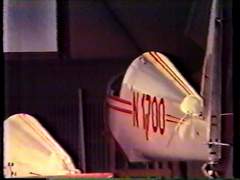
Her pilot's credentials stack up equally as well. Mira had already
captured the interest of many fans, both in the U.S. and in Europe
first back in 1953 when he made his freedom flight from Czechoslovakia
to West Germany in a commandeered airliner. For Mira, freedom is
far more than just a word, it is a way of life, a principal to be
honored, respected, and pursued, it is America. He closed one of
his letters to a friend in Santa Barbara by saying "I love
America." This refugee had been forced by his desire for freedom
to leave his beloved Czechoslovakia, and he found a new life and
home in America. Mira arrived in the USA with $3 in his pocket and
two shirts. When a friend said, "Let's buy you some new things,"
Mira answered, "Hey, what do you think I am, I'm just a poor
refugee!" Since then the name has stuck. It has been spoken
with pride at the National Air Races (Mira holds the 1964 National
championship)" and in the deadly screaming world of the unlimited
Hydros, Mira is the holder of the Gold Cup, Canadian Cup and the
President Cup, just to name a few of themany honors in this field.
It has been whispered by the wind slipping over the stress wires
of his beautiful Bucker Jungman as he performed at airshows, benefits,
and in acrobatic competitions. A Golden Czech Lion is painted on
the tail of his Bucker Jungman (this ship is now in the proud possession
of the world famous writer, Pilot, E. K. Gann). In some small way
Mira said he hoped this symbol would remind those who saw it that
he was a refugee from a country occupied by the Communists - a real
and true danger to man's freedom. This fact seems once again proven
by the recent action in Czech -- "America has given me a home
and a chance to go as far as my efforts will carry me and I love
her." Here is a man who with no sponsor or financial help,
spent his own hard-earned cash and vacation to challenge something
that was said to be impossible.
With this man and this plane, the North Atlantic truly had a worthy
adversary. All of her 36 hp buzzed with excitement as Herr Kruber
(Sportavia Test Pilot) ran the single wheeled landing gear down
the grass runway at Dahlemer Binz one bounce, two bounces and the
Spirit of Santa Paula was no longer just a beautiful
inanimate form of wood and metal, but an airborne living thing.
She reached skyward on hollow wooden wing bones of man's own fashioning
to sift the clouds of destiny. There is a miracle in flight and
fortunate indeed are those who have had the chance to embrace it.
After a series of prescribed flight tests and checks, the Spirit
was baptized N1700 and ready to go. Now it was Mira's turn and within
a few seconds the bubble canopy clicked shut, locked, and a bond
between man and machine was sealed, which would carry them both
one-third the distance around the world.

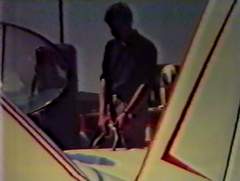
May 7, 1968 TAKE-OFF
During takeoff, the Spirit strained with the weight of her loaded
gas tanks to free herself from the earth's surface. A small crowd
of well wishers watched the little
ship bounce down the field and inwardly strained too, then suddenly
the grassy runway clawed no longer at the single wheel, but launched
Mira and the RF4
skyward and up over the tips of the pine trees that ringed the small
airstrip, past a shattered bunker now overgrown with spring ferns
that seemed to whisper,
"unity and freedom are possible in spite of man's inhumanity
to man."
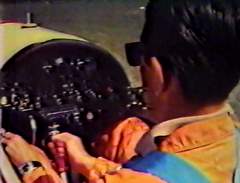
A last friendly wave of the wings to Kathy, one of the young glider
pilots, as she guided her bicycle down the country road back to
the village. Up the Spirit climbed, to reach beyond the clouds,
to seek adventure where it lie, to explore over the horizon. Mira
locked the throttle at 3200 RPM and set a course for Belgium.
Through these. Same skies many brave men and highly tuned combat
machines suffered and triumphed and changed the nature of the world
as they danced their deadly quadrilles.
On the Spirit flew and the miles moved by beneath her stationary
wings. It was time for a position check, a glance at the radio compass,
clock and map. To the east, a short flight away, lay the Iron Curtain
countries, Czechoslovakia, land of Mira's childhood, a land which
recently had expressed the desire to be free and shape her own destiny
and, for this, had once again been trod upon by Russian boots and
tanks.
Ahead lay Belgium and Brussels, with her magnificent churches and
towering buildings. Brussels is not a museum, it is a blending of
the living past and modern new shapes. It is as old' as yesterday's
civilization and as young as tomorrow's architecture. Above her
skyline purred the Spirit unnoticed except for a few school boys
who lay on their backs in a park, counting clouds as they drifted
by. On to Dunkirk and over beaches where history is a part of the
present.
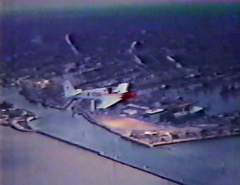
Mira turned the little ship away from the shoreline and for the
first time the Spirit and he moved through air supported only by
the sea. Man has always had a desire to discipline the sea; a desire
which is satisfying because it can never be fulfilled the challenge
of the sea is timeless. A thousand years ago the long hulls of the
Viking ships cut through these same waters on a similar attempt
to carry their crews to far off America and, with determination,
succeeded.
Time to pump some petrol from the wing tanks into the gravity feed
system secured just behind the fire- wall. Twenty minutes passed,
then a spray of gasoline over the windshield announced that the
job had been accomplished and the nose tank was filled to the brim.
By now those fluffy summer clouds had taken on a new dimension
and a heavy rain was threatening. Ahead, Dover with her white cliffs
glowing a dignified English welcome. To fly along Dover's white
walls is a magical thing the past seems to reach forward to you,
or perhaps your imagination is drawn back. There radiates an alliance
with the men who flew here before a bond welded together by the
presence of Dover and the freedom of flight.
The storm was increasing and the visibility continued to lessen.
Soon the wind-driven rain closed in on the little plane, blotting
out both land and sky. Mira could no longer see the rolling English
farm lands, but the Spirit and he continued straight on course with
the aid of the invisible eyes of the Luton radar. A safe landing
at Luton, a few cups of hot tea, and story swapping at the pilot's
club, then Mira and the Spirit flew on five and one-half, wet hours
later, Glaskow, Scotland.
For five days and nights rain dripped from the Spirit's cold exhaust
pipes and an attempt at crossing the Atlantic seemed impossible.
Then came the first encouraging weather report a high pressure area
was building over Greenland then sure enough, six hours later the
clouds around Glaskow began to break and Mira pointed the Spirit's
nose toward Stornoway. One hour passed and so did the good weather.
The Spirit and Mira there back to the same old game of rain, head
winds, and poor visibility
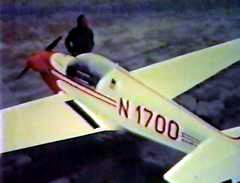 . .
No single phrase can describe the Scottish countryside that passes
below the Spirit in this part of the world. Gale-force winds from
the North Atlantic can, without warning, roll a blizzard across
the mountain tops, while spring flowers sway in the mild air of
Ardamurchan. To seaward, Staffa Island with its renowned basaltic
columns and awesome Fingal`s cave.
The rain had stopped now and clouds become scattered. Long columns
of sunlight reached down and dried the Spirit's wings and warmed
her pilot. Ahead and to the right the rugged grandeur of Glencoe,
a land of mountains, skiing, and wildly cascading rivers and streams.
This was the training ground for Sir John Hunt and the party of
climbers he led to the top of Mt. Everest. More time passed and
so did the miles, then ahead ten minutes away, Stornaway. After
landing, Mira received quite a reception. Dozens of people lined
the airport, but their look was not of admiration but rather one
of amazement and pity. They seemed to ask "What kind of a nut
would try to cross the Atlantic in a Mickey Mouse little airplane
like that?" Then Mira, feeling their thoughts, patted the Spirit
on its spinner, shrugged his shoulders, and simply said "me."
But deep inside a voice was saying, "Could it really be done,
or has my enthusiasm been deceiving me?" Before Mira could
ponder the problem any longer, his thoughts were interrupted by
the delivery of a telegram. It read simply, "We love the Spirit
of Santa Paula, we love Mira Slovak," and it was signed by
four kids from Santa Paula. After reading that telegram, Mira knew
all ideas of turning back had been shot down. As he said, "There
were four kids thousands of miles away who believed in me and my
airplane. I had to go if only to fulfill the confidence these kids.
Had in me and the Spirit."
The Spirit's tanks were filled to her 36 gallon capacity, oil checked,
it was fine, and once again Mira and the small plane tested their
footing over water. The
land disappeared slowly behind the Spirit, a glance back, a quiet
prayer, and ahead the vast Atlantic.
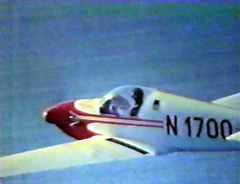
A friend and he had jokingly discussed painting green fields, cows
and farm houses on the top of the Spirit's wings. Then when Mira
was in the middle of the ice
floes of the North Atlantic, he could slink very low in the small
cockpit and see only the peaceful landscapes offering many safe
places to land.
The awesome vastness of this area is difficult to comprehend. Even
while flying in the warm, safe confines of a modern Icelandic Airliner,
one is aware of the immensity of this part of the world.
Mira kept his heading and the timeless sea glided by below. Each
wave seemed the same, yet somehow different, rising and falling
and each time washing their heads
with white foam. From 3000 feet it didn't seem possible that this
softly swaying blueness was the icy, devastating North Atlantic
an ocean that could speak with a fearful roar and has tossed one-ton
boulders a hundred feet on the north side of the Faeroe Islands.
It takes courage to sail out on the North Atlantic to cast your
nets and luck to the sea off Greenland or the Iceland banks. Just
such courage is found in the Faeroe Islanders and their home was
Mira's next stop.
Co-author's note: This was as far as I flew with Mira, as the safety
of a commercial airliner over the Atlantic held more appeal to me.
We were to rendezvous
at Santa Paula in a week. Here now in Mira's own words, the Atlantic
crossing.
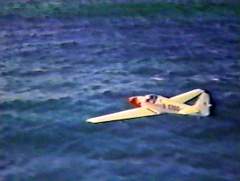
I thought it was low clouds because clouds were getting thicker
and thicker'all around me and I was flying under them, When I looked
closer, a few minutes later,'
I could recognize the hills of the Faeroe Islands. There were about
4 or 5 islands together and the airport was located on the north
side of the island in a little fjord. When I proceeded to these
islands, I could see heavy clouds surrounding my proposed landing
place, the airport of Vagar. When I came real close to it, the visibility
was reduced down to less than 2 miles and I was encountering heavy
snow showers. When the snow hit my windshield, it turned to water
but fortunately it didn't freeze. Right away I called on the radio
to Vagar tower and they advised that I should stand by, that the
airport was closed. The tower operator explained that they were
working on the runway and only half of it was finished, as they
were putting a new asphalt cover on it. I told them I was having
ice problems and with the heavy snow showers around me, I was afraid
I may pick up ice and I would never reach Iceland unless I wanted
to swim the rest of the way. He said it would take at least 15 to
20 minutes before they could clear away the equipment. Frantically
I circled, trying hard not to lose sight of the runway. The snow
showers were almost unbearable as they were blinding me. The low
ceiling and the snow blowing against the windshield so rapidly prevented
my finding my;way out of the storm. I had to go down - one way or
the other! Luckily, after 15 minutes they had moved their equipment
and allowed me to land. I was anxious to get down as soon as possible,
as I was afraid I would lose sight of the runway. Finally, I got
the landing clearance and the tower advised that the runway was
full of holes. When I touched down, I thought the airplane was going
to come completely apart. After a few bounces anda few hair raising
moments, I finally came to a stop and was very happy to be on -
the ground and see the people.
They gave me a funny look because the airplane I was flying in
wasn't exactly the kind of plane you would fly over the Atlantic.
It was only a little Put-Put!After a brief explanation of my forced
landing, they took it nicely and said "you have your problems
and we have ours with this runway." So I spent the rest of
the afternoon there and the people were quite nice and spoke fluent
English.
The evening was very pleasantly spent and I met quite a few Danish
people who were very hospitable. I retired that evening in a little
hotel with a pleasant
feeling of satisfaction. The 1st leg of my journey was over.
The next morning, there was beautiful sunshine which was a good
indication that I could depart. After checking the weather with
Iceland, the forecast looked very promising with only a few snow
showers on the way and some rain showers on the East Coast of Iceland.
My destination point, Reykjavik, was completely open.
After thanking the Danish people for their gracious hospitality
and taking a few pictures, I was on my way to Iceland. Once again
- - - nothing but water,clouds and loneliness. After 3 hours flying
time, and about 60 miles ahead of me, I could see the snow covered
mountains on the East Coast of Iceland. I contacted their radio
operator and before long we became involved in a conversation. He
asked me many questions about the structure of my powered glider
as he had been following my trip and was very interested in my airplane.
He expressed a desire to see it before I continued my journey. I
didn't intend to land there becauseof heavy cross winds, but thought
I would just circle a few times over the airport, wave my wings
for "so long" and proceed on my way to Reykjavik.It's
amazing that such a little country like Iceland could have so much
different weather. Within half an hour I saw a dark cloud ahead
of me. Approaching it, I knew it was blowing lava dust. It reminded
me of dust storms in El Paso in the south side of Texas. So after
spending half an hour getting out of the lava storm, I went through
a snow storm. A half hour later I came to a rain storm and a half
hour after that I knew I should be approaching Reykjavik and I was
in beautiful sunshine.
After landing in the Reykjavik International Airport, there were,
as always, people wondering who was trying to fly the Atlantic in
a little airplane like that. After normal customs procedures, I
spent the rest of the afternoon preparing my airplane for the next
morning's journey. Checking with the weatherman, the weather
ahead of me looked real good. So I spent the rest of the afternoon
in the control room. I listened as SAS, TWA, Pan American, and Lufthansa
went by. Myself beingan airline pilot, I of course have a pretty
close understanding with the controllers who are running our lives
on the ground with the radar as we're flying the machines in the
air. It was a very pleasant visit.
Before I left, I was introduced to Mr. Hanson, Chief of Aviation
in Iceland. A very quiet, unassuming gentleman who had very nice
words to say. He used to fly
gliders many years ago and is still a great fan of glider flying.
This man, I am sure, is No. 1 in Iceland aviation. I soon learned
that we had a great deal in common as we were both owners of the
same type of aerobatic airplane, the Zlin. I also learned that this
gentleman pioneered the interest of aerobatics in Iceland, by being
the first aerobatic instructor. He also established rescue units
by being the 1st to jump - after never having done it before. He
was truly a very exceptional man.
After a long friendly discussion, we parted - hoping to meet again.
At 4:00 in the morning I was on my way to Kulusuk, which was my
next planned landing in
Greenland. I knew this would be the longest stretch over open water.
I was fully loaded with fuel so I had to fly very low. After 45
minutes I looked back
and there was no more Iceland and there was no more Reykjavik. Just
a few clouds here and there and the weather ahead looked pretty
good. The sky and the ocean were blue and it reminded me of flying
some place close to Hawaii, certainly not in the cold Atlantic.
From the low altitude, I could see the gentle rolling swells
which gave the appearance of a very peaceful sea. However, I soon
changed my mind when about 1-1/2 hours later I saw a huge cargo
ship being tossed and turnedlike a little toy. It gave me the idea
that the little swells had not been so little but they were terrific
great walls of water. Somehow through my mind came
the thought, "What would happen if I had to go down?"
Well, I didn't want to think about it. I was just hoping that the
little "Putt-Putt" Volkswagen ahead of me was never going
to stop turning, and the little airplane never stop flying, because
it would be a very long; lonely swim to Greenland or back to Reykjavi1k.
The weatherman was actually giving me a very favorable wind. I planned
on 6 hr. 15 min. my total flight from Reykjavik to Kulusuk. After
3 hours, the clouds
started picking up from nowhere and here and there I could see little
thunderstorm clouds working their way through the rain and snow.
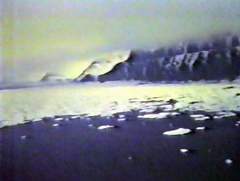
I have seen on this journey the rain falling practically from no
place. I have watched new clouds form which I never have experienced
in my 23 years of flying
or have I ever seen anything similar to it. I tried to stay away
from any kind of liquid sunshine or any kind of snow showers because
I didn't want to pick up
any ice. I flew through the clouds,, left and right and once in
a while I could see the ocean - still blue - but no longer the nice
peaceful rolling waves. Now
they were nasty, choppy ones, which would give me an indication
after reading marine books and talking to the old navy boys, that
if there are heavy chops in
the sea, there is pretty good velocity wind blowing. A short time
later, I found that instead of forecasted tail winds, I was experiencing
30-40 knots head wind.
Actually my water speed, or ground speed over water was roughly
around 50 MPH. I was too far away to reach anyone on radio. I wanted
to advise the Atlantic
Radio Control that my estimated time of arrival in Kulusuk would
be approximately 1-1/2 hours overdue, due to the unexpected winds.
I realized it would be 3 to
3-1/2 hours before I would be able to reach any kind of station
on the east shore of Greenland. So I sank a little deeper into my
seat, avoiding to see the choppy
water below, and I couldn't help some of the thoughts that kept
creeping into my mind. Here I am, hours from anybody. In case I
have to go down, it would be a
long time before they found me. I had all the emergency equipment
which would locate me for the Air Force Rescue team, but there was
still little chance to be
found. It was a very lonely feeling. Away from civilization —
just by myself. My life depending on a little 36 h.p. automobile
engine that is going to get me
where I am trying to go. And thoughts came through my mind of the
importance of a human being and believe you me, if at any time in
the past I ever thought of
myself as being somebody, this was the morning of honest confession
with myself. How insignificant a human being, among the wasteland
of nothing. I have never
seen so much of nothing in my life. And in case something goes wrong,
with no protection one has only 4 minutes to survive in the cold
water. Of course, I was
wearing a rubber suit which would give me approximately 3 hours
to survive. In a dingy, which was for 3 to 4 people, would give
me 2 days. I had food for only
5 days. But the icy wind and the bitter cold temperature would make
it impossible to say if one could possibly survive more than a couple
of days in this part of the
country.
So, I pushed my way through, looking at the blue and white chops
of the ocean once in a while and checking the wind so I could roughly
maintain my preestablished
heading. After 4 hours I very anxiously started tuning my radio
compass and tried to pick up Big Gun Radio beacon. In a book of
a U.S. airport it says at 200
knotical miles one should be able to receive the signal and get
some kind of a bearing out of ADF which is a direction finder. After
a few minutes tuning, I
was unable to reach a station, so I thought I might have been slowed
down by the strong headwind. Perhaps I could pick it up in the next
one hour. An hour went
by and still no station. It gave me an indication that I was completely
out of my course somewhere in the blue yonder of the North Pole
or someplace coming close
to the South of Greenland which was practically impossible to reach
with only 11 hours of fuel. So thoughts again went through my mind
that I had made a mistake
someplace. There were clouds all around me and once in a while I
could see the,ocean and a few ice burgs floating around the Atlantic
Ocean. It was a funny
feeling that somehow I had betrayed myself. I had a guilty conscience
of goofing it up. Something went wrong someplace because the compass
was swaying 20 degrees left and 20r..degrees right and my standby
compass I had to hold in my hand to compare with my main compass.
They both agreed. After being up-in the air for 7 hours, which was
45 minutes overdue, and unable to pick up a radio station, I started
giving up. There was not much I could do. I didn't look down too
much. I just tried to follow the compass closely as much as I could.
I knew definitely something went wrong, but how, where and what
I couldn't figure out. Then, all at once, out of a fairy tale, I
sneaked through a bunch of clouds ahead of me, and right there in
front of me was a magnificent, rough, rugged mountain terrain of
Greenland. It was. approximately 40 miles ahead of me. A few degrees
to-, the right, I could barely see terrific great antennas which
belonged to the radar station of
Kulusuk on the East Coast of Greenland. So, I tried the radio again
and I still couldn't receive anything on my radio compass. Finally
I contacted the radar station which was owned and operated by the
United States Air Force. A very anxious voice came through and said,
"Where have you been? You are practically 2 hours over your
ETA and everybody has been impatient and worried because it looked
like you had to go down. We were just about ready to send a search
party for you." Well, I explained that there was heavy wind
blowing that I didn't expect. It was stronger than I had anticipates
and that caused my 1-1/2 hour delay. So, in turn, I asked, "What
happened to your radio beacon? I was unable to receive it on my
set." He said "Well, two days ago we turned it off for
maintenance . . . ." So,
all my being scared, the guilty conscience, the uncertainty and
the distrust in my ability all turned out to be for nothing.
After refueling and having a good Danish lunch, and the exchange
of nice words, I proceeded with their blessing. I was on my way.
After takeoff, I got in touch
with their radar and asked if it was possible to. give me radar
vector. They gave me a heading which I maintained and they asked
me if I could climb to 12,500 ft.
Of course on this trip, the most I had gotten out of the airplane
was 6,000 feet, and to reach 12,000 seemed practically impossible.
But I was willing to give it a try. At the minimum I had to have
10,500 because the top of the plateus of Greenland was 10,000 ft.
So I had 500 ft. to spare. After 1-1/2 hours I contacted the radar
man again. I had really lucked out. I was at 10,500 feet! "Good
for you," said the radar operator, "but you better be
careful. In the past month we have lost 3 pilots." I couldn't
understand why because there was a clear beautiful sky. However,
around half an hour later when I approached the highest plateau,
10,000 ft., I could see what he meant. When I looked to the right,
the horizon completely faded into snow or ice and there was no way
of telling if one was right side up or upside down. My turn and
bank indicator wasn't very reliable. I had no other gyroscopic instrument
to maintain my attitude. The only way I could keepmy balance was
to look at the sun and the reflection on the ice. With these two
points I was able to maintain my straight and level position. It
was amazing and hard to describe how it feels to be in a big tunnel
where everything is all white around you. Everyone seemed to think
this would be the most difficult part of my trip because of the
presence of vertigo and unexpected winds. To me, I think it was
the easiest part. If I had a choice, I would prefer to make an emergency
landing on snow rather than water.
When I approached the second radar station, the air traffic was
very light so the radar boys asked me to circle around the station.
They said they were 15 miles
ahead of me. L looked and looked but could find nothing. All of
a sudden, right before me were huge antennas sticking up every place.
I thought it was a mirage. I
made a circle over them, but for some reason they still couldn't
see me. I made two 360's and kept going to Sondrestrome, later learning
that one of the radar operators had purc,ased an RF4 similar to
the one I was flying. After landing in Sondrestrome, which is half
operated by the United States Air Force and half by SAS Airlines,
theZield officer came to me and asked if I had permission to land.
I advised that I did. He informed me that it would cost me $200
for this landing because they require $500,000 Liability Insurance.
Since I had already paid this amount for the insurance, I was really
surprised when I registered in the SAS office that I hadto pay an
additional $198 for landing fees. I practically had a heart attack!
I tried to find out what happened! "What am I paying it for?"
I asked. "Well," he
said, "you have to pay for the services." I said "I
don't need any services!" He replied "Well, you have to
pay for the fee for your starting unit." I said"Listen,
I don't have any starting unit. The way I start my engine is with
a little jerk by hand 'and the engine starts." He answered
"You have to pay for the hanger." By now I was upset and
I said "I don't need any hangar. It's sitting outside. It's
been sitting outside ever since I landed." I knew I was never
going tol:win. His lastcomment to me was, "I don't know what
it is, but it's some kind of a fee required by the United States
Air Force and I have to get it from you." Well, I was angry,
but I paid the $198 landing fee in Sondrestrome. But I told myself
that I would never land around Sondrestrome again. It was the most
expensive landing fee I have ever seen in my life! Total: $398.00!
After finishing all the formalities, and while I was preparing
my little airplane for the next day's trip, I saw that I was surrounded
by quite a few Air Force technicians and pilots. Most of them just
shook their heads. How can you explain to someone who never will
be convinced that the impossible should be left alone.I realized
this, when in a later conversation, one of the men explained to
me that he had lost quite a few friends over those big iceburgs
and they were flying much stronger, safer aircraft than I. Why would
I even attempt it in a little single engine, 36 h.p. glider. It
was beyond their imagination. Well, it was behind me. I felt comfortable,
but I knew it was going to be a long time before I would tryit again.
I spent the night in a place where all night is daylight because
the sun never goes down. Around 4:00 I got up and it was like daytime.
I got everything organized and filled up with automobile gasoline
and again, after 6:00, I was on my way via Cape Dyer to the landing
place of Frobicher, which is in Northwest Territory of Canada.
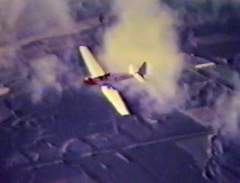
After takeoff I started climbing and tried to pick up the altitude.
The weatherwas beautiful. The sea looked to be smooth and the wind
was practically nil. Again
I had 250 knotical miles over open sea. This part of the ocean was
loaded with ice burgs and a bunch of ice cubes were floating up
and down. Looking down, I got a
chill on my back because it would be very uncomfortable to try to
make a landing. I tried to pick out a spot where, if I had to, I
could make an emergency landing.
The areas were too small and I would be sure to hit an ice burg
or chunk of ice.It would probably tear me apart on impact. So, not
looking downstairs, just looking
ahead of me, I tried to follow my compass as closely as I could
because the variation came to the maximum of plus 52 degrees west.
If I want to maintain my true course heading 270, I had to be indicating
on my compass a 322 degrees or 52 degree differential.
I picked up my heading from Cape Dyer to Frobicher. Again 250 knotical
miles which was around 3-1/2 hours flying time. I flew over the
peaceful countryside of Canada with the most beautiful hills I have
ever seen. It reminded me of the good old days of Christmas that
I spent skiing in the Sierra Mountains. Actually it reminded me
more of Sun Valley because of the nice, gentle, rolling hills. Of
course I doubt if there was any kind of human life or any type of
animal life in this part of the country. It looked very forbidding.
To make my onliness a little more tolerable, I began to look around.
I noticed that my engine temperature went up 20° and my oil
pressure had gone down about 5 lbs., which concerned me greatly.
I tried to decide if I should go back to Cape Dyer or proceed to
Frobicher. My eyes were glued to the engine instruments.However,
after a short period they stabilized and didn't move. Not having
an outside temperature indicator, I stuck my hand through the window
and saw that the air outside was much warmer which was an indication,of
inversion. So my worries were over. After 'eaving what I call the
beautiful "Sun Valley Hills", I again went over a long
stretch of water. Not until approxi-mately 25-30 miles was I able
to receive Frobicher radio beacon which brought me right over the
airport. I made a nice gentle approach. Since Frobicher does not
have a control tower, the radio man was located in a little settlement
about one mile away from the airport. He advised that there was
a little activity on the left side of the runway. A group of photographers
were there waiting for me. I asked what they were doing there and
he replied, "Well, it doesn't happen every day that somebody
is flying a powered glider over the Atlantic." I had to chuckle
a little bit with a feeling that it was true - I had been scared
quite a few times, but it wasn't so impossible like many people
expected.
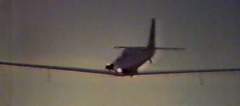
After normal approach and touch down, I parked the airplane, and
found to my surprise, over a hundred eskimo school kids waiting
for me. This was a holiday for
them! When they heard of the flight across the Atlantic, the teachers
gave them 1/2 day off from school to come see the plane land. All
the kids had a chance to peak inside the cockpit to see how it looks
in a single engine airplane. I received a very nice, friendly welcome
by the Canadians, spending my evening with some very interesting
people. I learned that the Canadian Government was providing the
eskimo people with a special task force who were helping them find
a better way
of life. This is a terrific effort on the part of the Canadian Government,
when I think of how these people used to live. They appeared to
be very happy, and thankful
that the Canadian people were taking care of them.
I stayed in a beautiful hotel where everything was spotless and
clean and the food was excellent. After a nice comfortable shower,
a good full stomach;, I retired.
The next morning, I found that everything was fogged in. The weatherman
said that Frobicher Bay was under fog, but the top of the fog was
around 2,000 ft. and everything else all the way down south was
clear. I didn't have the desire to try togo over the overcast because
I knew that there was a certain amount of ice available in these
clouds, I waited until I could see the sun a little, and after normal
clearance, I took off with an IFR departure. I tried to go through
the overcast
which took me a bit longer than I had expected because of my heavy
weight and a little ice which I had picked up. When I broke out
at around 1800 feet, I was in
a beautiful, blue, clear sky. My next stop was Fort Chimo, estimated
flying time 6-1/2 hours. The forecast said it was to stay clear.
After flying approximately
5 hours, I found I was unable to pick up radio beacon because my
average level was approximately 3,000 to 4,000 feet, which is not
high enough to receive good radio reception. I was getting a little
nervous because I was coming close to Fort Chimo. There were a few
breaks in the overcast, and I could see what I wasn't sure was theground
or the snow covered Hudson Strait. The curiousity and also the uncertainty
ofnot knowing where I was, told me I'd better investigate. According
to my flight plan, I should have been approximately one mile away
from the shore and it should be very easy to recognize because of
the small hills close to the Hudson..Strait. Ifound a small opening,
I put my one landing gear and spoilers down and I practically dove
right through the hole. When I reached the bottom of the overcast,
I found myself to be exactly where I wanted. Right on the shore.
BEcause it is practically impossible to follow in one mile visibility
in a 500 ft. ceiling and I was afraid of getting into trouble and
my reception would be even worse than it was at 4,000 ft., I knew
I had better go back to where I came from. Nice, comfortable smooth
air, and sunshine. I started looking for the opening in the sky
in which I went down. It was gone. I started snooping around like
a cat looking for a mouse and there wasn't an opening of any kind
in my vicinity. I had no;choice but to go on the instruments and
try to climb to my original altitude. I wasn't too happy because
I didn't want to run into icy conditions which I knew existed at
1,500 ft. Around 400 feet I picked up the maximum speed I could
get out of it with an open throttle which was 120 mph, and I started
to establish my climb. When I hit the overcast, right away there
were little drops on my windshield which was a good indication of
ice present in the higher 'clouds. I could feel I was getting heavier
and heavier. In 20 minutes there was so much ice on my windshield
that I could not even see the engine cowling in from of me. The
HF antennae which spanned from the right wing tip to the top of
the rudder picked up so much ice that the vibration nearly broke
the tail off. How long the rudder could take it and how long before
the antennae would break, I didn't know. After several moments of
heavy perspiration, I finally made it. It seemed like an eternity
before I was on top again. I could see the blue yonder and the shiny
sun. It was the most beautiful picture I have ever seen. It took
approximately another 1/2 hour;..before the sun hit the ice and
melted it. Finally, the airplane became normal again and there wasn't
any more jumping around like a little young horse - up and down
in the sky. I was relieved, and finally after another hour of flying
time, I started getting out of the overcast and found my way to
Fort Chimo. Upon landing, I met the same curious faces that I had
met in every landing before. I refueled my little Putt-Putt and
was anxiously on my wayto Knob Lake. After takeoff, I followed quite
a few lakes put together which looked like a long river and would
ease up my navigational difficulties because Knob Lake was forecasting
snow showers with rain showers that evening. I was roughly 60 miles
away from Knob Lake when I ran out of the "togetherness"
of lakes. The only naviagational source of knowing where I was.
Every hill below me started looking like every other hill. I knew
approximately where I was, but I wasn't sure. I had to fly around
a few snow showers which created more problems. I just hoped that
my luck would hold so I could sneak in.
Approximately 10 miles from Knob Lake, I was approaching undesirable,
low ceiling type of weather which was forcing me down close to the
ground. This country was completely out of civilization - with no
sign of life at all. It would have been very hard to find a place
to land - and even harder to find someone, should they
have to come pick you up. It brought to mind Ernie K. Gann's book
"Fate is the Hunter". It was in this part of the country
that one of their airplanes wag: lost.I just hoped that I wasn't
going to be as unlucky as these people were.My hopes of finding
the haven of the airport were getting thinner and thinner. My fears
were getting greater when all of a sudden, out of nowhere I saw
a telephone pole. A telephone pole to a normal human being in a
civilized country doesn't mean too much. But for-a man who isapproximately
6-1/2 hours away in nobodies land, to see a telephone pole here
in front of my nose = it was a beautiful sight. If somebody was
willing to give me a million dollars in place of that telephone
pole, I would take the telephone pole. If things are going to go
wrong - if I have to go down - I'm always going to find where the
people are if I follow those telephone poles. So, with the snow
falling here and there, I followed the poles. I could see houses
and shacks, once in a while I would see a car go by. I was approximately
300 feet over them - and happy to be there. In my excitement to
see them, I was waving my wings and probably the people on the ground
thought "What's wrong with that ioy?" Before very long
I could see housing projects surrounding a small airport. As there
were no radio contacts or radio control, I just put the gear down
and prepared to land. It was a wonderful feeling. A feeling of accomplishment.
From now on, I have it made.
From Shepardville down to Septisle it was beautiful. It was a straight
railroad. I flew IFR. Not "Instrument Flight Rules," but
"I follow the Rail Road." Looking back,
never in my life have I ever seen so much of nothing or been so
scared. Not because I did not trust myself. Not because I did not
trust the airplane. But the feeling of insecurity was always there.
Just knowing that at anytime - anything could go wrong.
After landing and enjoying a shower (which was the first in a long
time), I found a Post Office where I sent Mr. Ernie K. Gann a telegram.
Mr. Gann is the author of "Fate is the Hunter." A very
famous book of a pilot's world and was dedicated to men who flew
in the second war in this part of the country. I would appreciate
the book and I could appreciate the man who wrote it because he
was oneof those pilots. My telegram read "Today, Fate was my
Chaser." The next day I followed the railroad all the way down
to Seven Islands. I was coming closer to civilization, the clouds
were disappearing and when I arrived, it was a beautiful day.
From there I went on to Quebec, Montreal and before long I was
off for the good ole USA. While crossing. the bridge from Canada
into. the United States, I had a terrific feeling. I couldn't keep
myself from singing as loud as I could "America-America".
I couldn't help waving the wings of the plane and again the people
probably wondered what was wrong with that guy upstairs. I was overjoyed
with the feeling of success. I had done it! I was at home! And now
it was like a dream. Just keep
going and in a few days I would really be home!
While checking the Customs in Ogdensburg, the man was kind of surprised
when he saw the diving gear. He asked if I had been fishing with
my skin diving gear. I said "Not exactly fishing, but I was
ready for it if I had to go down." He didn't know what I meant,
and I didn't try to explain. From there I went to Tri-Cities. Due
to heavy thunderstorms in the area, I had to spend the night. The
next day, more rain, but I tried to work my way to Youngstown. Before
I reached it I was forced to go down and wait a few hours due to
a heavy storm. Then I was on my way to Wooster, Ohio where Sportavia,
who sells the RF4, had a factory representative.
From there I flew to Wichita: From Wichita to Las Vegas where I
was to practice on the hydroplane of Harrah's Club. I took a few
fast rides on Lake Meade and
spent the day with the crew discussing our chances in the hydroplane
season. The next mVcbning I was asked to go to Los Angeles via Reno
when I arrived at Reno there was quite a surprise. Television, newspapers
and radio were waiting for me with Mr. and Mrs. Harrah as hosts.
I had heard that the Antique Aircraft/Air Show was in progress
in Watsonville, California and some good friends of mine from Santa
Paula were there with their
newly rebuilt Curtiss-Robins from 1929 vintage. They were real surprised
when theysaw me land and the next day we decided we would fly formation
all the way to
Santa Paula. Flying their Curtiss-Robins were Perry Schreffler,
and Bob Van Ausdal, both TWA Captains. I was in my little Putt-Putt.
Approaching Santa Paula, we encountered pretty heavy turbulance
which was a good indication that they had some kind of a front going
through. The temperature was high - something was wrong. Anyway,
I flew along the coast of the ocean. Then we approached Ventura
and finally I could see some of Santa Paula. Part of the town, and
part of the airport. That was truly a marvelous feeling of accomplishment.
It was a great feeling because the entire journey was over. I saw
my final landing place. I saw the place I had dreamed of for so
many weeks. Actually I could sayfor so many months, I had made it.
I didn't break any records. I was no Lindbergh
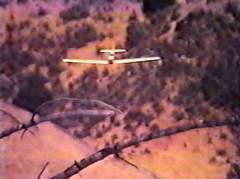
I was not the first guy to cross the Atlantic. I am not expecting
any trophies--I an not expecting any kind of reception or any kind
of special treatment. What I
have done, I have done through my own challenge. Everybody said
it could not be done. And I said Yes, it can be done. If it is properly
planned, if safety is obeyed,
if the common sense tells you go or not to go, then I believe it
could he done. Many people did not feel that way. But here I was.
Only a few minutes away from my home which I dreamed of for so long.
And now the dream came to reality.
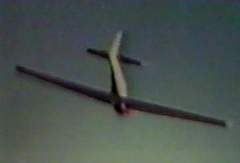
As I passed over the field I could see that many people had come
to see the Spirit of Santa Paula come home. All of a sudden I found
myself the victim of a heavy
downdraft. I had 300 feet and good speed, so there seemed to be
no problem for me to make it down. I even put the. landing gear
down. I flew away from the formation, looked at the runway and everything
seemed just great. But somehow the down draft still kept pushing
me down. I knew I could never make the runway so I headed for the
open field ahead of me. The downdraft was still bearing down. If
I kept going in the same direction, I was sure to hit the trailer
house ahead of me. That is when it happened. As I made a gentle
turn away from the trailer house, I fell out of the sky like somebody
shot me down. That's the last thing I remember.
When I became conscious seven days later, I was surprised at the
shape I was in. Plazma, blood, hanging left and right. I tried to
put things together. I tried to
remember what had happened. I remembered the trailer house, the
turn, and then nothing. For a week I was in a dream. I saw a few
faces which came and went in
a foggy type of feeling.
While in the hospital, I would look at the ceiling and try to figure
out what really happened. Where did I make the mistake? What went
wrong? How is it possible for
a man that flew 22 years to do something like that? To.:fall out
of the sky. never scratched ='''airplane before. And these words
and these questions come to me over and over again. I spent quite
a few sleepless nights and I still cannot figure it out. I could
blame somebody. I could blame the high temperature. I could blame
the heavy wind blowing - the hot, strong, Santa Anna Wind. I could
say that I put myself behind the eight ball. I could blame anything
I could think of, and it wouldn't be the truth. Probably the easiest
and the best way to sum it up, like my good old friend Ernie K.
Gann, when they asked him on a television show, "Do you believe
in fate?" He said, "Yes, I do. Look at Mira Slovak. flew
the Atlantic, 8,500 miles away, through lots of isolated country,
miserable weather, over places if he went down - nobody would ever
find him. A difficult trip in any kind of airplane. He did it in
a 36 horse power Volkswagen. He came home - he conquered the difficult
trip - he was 50 feet from his destination when he ran out of speed,
altitude and luck at the same time. Yes, I believe in fate."Perhaps
he was right . . . but, I still think that this time "Fate
was my Chaser."
|

PDF version of this article
|
|